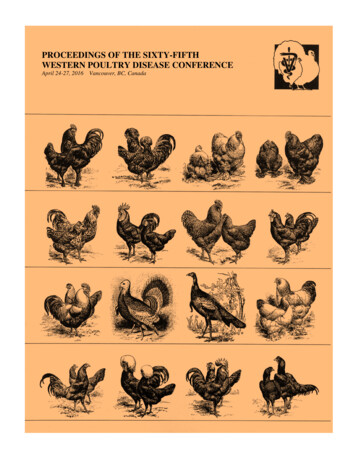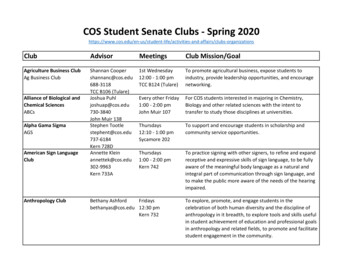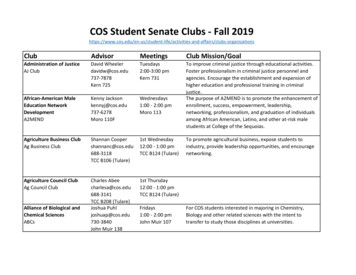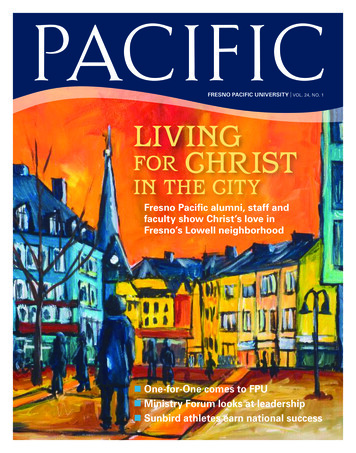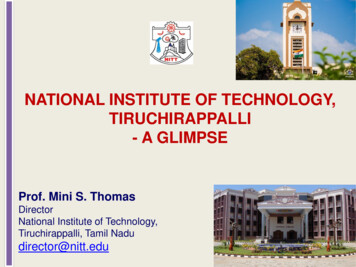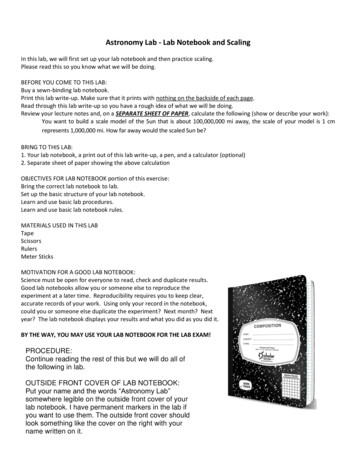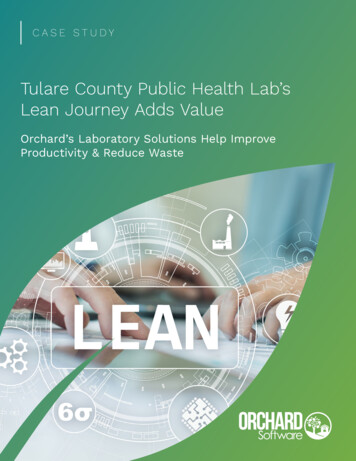
Transcription
Tulare County Public Health Lab’sLean Journey Adds ValueOrchard’s Laboratory Solutions Help ImproveProductivity & Reduce Waste
AbstractTulare County Public Health Laboratory (TCPHL) received an exciting grant, administered through theAssociation of Public Health Laboratories (APHL), to implement Lean practices that improve laboratoryefficiency. As part of its Lean toolkit, TCPHL selected Orchard Software’s laboratory informationsolutions to help streamline its processes, eliminate waste, and add value to its customers. CombiningLean concepts with a strong IT solution has achieved measurable improvements in quality and costsavings at TCPHL.AuthorKim Futrell, MT(ASCP), MSHICopyright 2022 Orchard Software CorporationAll Rights Reserved. No part of this document may be photocopied, reproduced, stored in a retrieval system, or transmitted in any form or by anymeans whether electronic, mechanical, or otherwise without the prior written permission of Orchard Software Corporation. Originally publishedin 2015; updated graphic imagery in 2022.Orchard Software Corporation701 Congressional Blvd. Suite 360 Carmel, IN 46032Phone 800-856-1948 www.orchardsoft.com
Tulare County Public Health Lab’s Lean Journey Adds ValueOrchard’s Laboratory Solutions Help Improve Productivity & Reduce WasteContentsIntroduction.5APHL Grant to Implement Lean. 5About Tulare County Public Health Lab. 5Lean Training & Certification Requirements.6Lean Boot Camp Graduates. 6Six Projects Underway. 6Orchard’s Lean Lab Solutions.7Orchard Harvest & Orchard Outreach as Lean Tools. 7Overview of Project Results Affected by Orchard Installation. 7Test Ordering.7Specimen Accessioning. 8Data Mining. 8Reporting. 8Lean Culture.8Lean is Not an Acronym. 8Volunteers Add to Lean Culture. 9Voice of the Customer. 9Eliminating Waste.10Addressing Customer Needs with Value-Adds.11Manage Change & Develop a Teamwork Culture.11Lean Tools. 13Executive Steering Committee (ESC).13Lean Daily Management Systems (LDMS).13Huddle Meetings. 13Primary Visual Display (PVD) Boards. 14Radar Charts. 14Kaizen Groups. 14More Lean Tools. 15Standard Work.15RACI Chart.16Value Stream Map.16Brown Paper.16Material Management (Kanban).16Visual Process Controls (Poka-Yoke).16Spaghetti Diagrams.17Single Piece Flow (Batch Control).175S.17Blitz.18Page 3
Tulare County Public Health Lab’s Lean Journey Adds ValueOrchard’s Laboratory Solutions Help Improve Productivity & Reduce WasteProject Charter. 18ProjectProjectProjectProjectProjectProject1: Test Ordering.182: Specimen Accessioning.193: Inventory Management.204: Data Mining.205: Communication During Surge.216: Data Mining & Reporting. 22Making Measurable Advancements. 23Positive about the Possibilities. 24Page 4
Tulare County Public Health Lab’s Lean Journey Adds ValueOrchard’s Laboratory Solutions Help Improve Productivity & Reduce WasteIntroductionAPHL Grant to Implement LeanTulare County Public Health Laboratory (TCPHL) was one of four labs that received an excitinggrant administered through the Association of Public Health Laboratories (APHL) to implement Leanpractices. Lean is a quality improvement process that systematically looks at processes to eliminatewaste and identify ways to improve sustainability. APHL promotes this initiative with the goal ofencouraging projects that are geared toward improving lab sustainability across the country.About Tulare County Public Health LabTCPHL, located in Tulare, California, rests in a 6,750-square foot building built in 1992. The labis connected to a 1920s-era building that served as the county hospital and now houses localgovernment offices and a health clinic.In 2005, the lab gained a new BSL-3 suite and negative air pressure anteroom to accommodatehigh-risk agents and rapid bioterrorism rule-out or confirmation. TCPHL supports public healthprograms, testing in support of outbreak investigations, surveillance, and public health emergenciesin Tulare County and the surrounding regions in conjunction with the California Department of PublicHealth (CDPH) and the Centers for Disease Control and Prevention (CDC).Denise Lopez, MS, PHM, LaboratoryManager, and EnvironmentalLaboratory Accreditation ProgramDirector for water testing, overseesTulare’s lab, with consultationservices provided by Robin Purves,MS, PHM. They employ three milktechnicians, two lab assistants,one office assistant, and five publichealth microbiologists (PHM),including dual-licensed PHM/clinicallaboratory scientists; see Figure 1.TCPHL has a solid reputationin its area, annually performingFigure 1: TCPHL Staffapproximately 42,000 tests witha budget of 1.1 million. Their highest volume is in dairy testing. The lab also performs drinkingwater, chlamydia/gonorrhea, TB, and HIV testing. Most remarkable is the broad diversity of servicesprovided by such a small staff. The lab is able to accomplish this because its staff members arehighly cross-trained in challenging specialties such as bacteriology, parasitology, mycobacteriology,molecular diagnostics, serology, and mycology. Although very successful, Tulare plans to becomeeven more efficient in providing outstanding service and has readily embraced the Lean challenge.Page 5
Tulare County Public Health Lab’s Lean Journey Adds ValueOrchard’s Laboratory Solutions Help Improve Productivity & Reduce WasteLean Training & Certification RequirementsLean Boot Camp GraduatesFifteen public health lab professionals from across the country attended a two-week Lean “bootcamp,” where they were introduced to the basics of Lean and had an opportunity to work throughsimulated Lean exercises using Lean tools. During boot camp, three of the 15 individuals wereselected to be financially supported to go on to become Certified Lean leaders. A staff memberfrom Tulare County was one of those selected. The year-long certification process was done inconjunction with a contracted Lean consultant from Becton, Dickinson and Company (BD) andsupport from APHL. During the course of the boot camp and certification process, participantslearned strategies for developing a Lean culture, such as managing change, running effectivemeetings, engaging and empowering workers, managing resistors, and using Lean tools.During the initial year of Lean implementation,participants are required to charter and complete atleast three projects, using all their Lean tools at leastonce. At the end of the project, results are presentedto their company’s executive steering committeeto complete the certification process—but that iscertainly not the end of the Lean journey. Lean is anongoing work toward improvement and the beginningof a new culture.Six Projects UnderwayAlthough the requirement was to tackle threeprojects, TCPHL is in the process of six projects,each touched by the LIS in one way or another; seeFigure 2. The lab will use Lean tools such as spaghettidiagrams, value stream mapping, brown papers, andmore to delve into each of the project categories.Quality improvement is monitored throughout,targeting the reduction of “up-front” errors thatcan have significant downstream effects, such ascollecting the wrong specimen, having incompletetest order information, and errors in data entry.Test a MiningCommunicationDuring SurgeReportingFigure 2: TCPHL’s Six Lean ProjectsPage 6
Tulare County Public Health Lab’s Lean Journey Adds ValueOrchard’s Laboratory Solutions Help Improve Productivity & Reduce WasteOrchard’s Lean Lab SolutionsOrchard Harvest & Orchard Outreach as Lean ToolsWhat is unique about TCPHL’s Lean journey is that, in addition to the Lean tools, they simultaneouslyimplemented Orchard Harvest and Orchard Outreach as additional quality improvement toolsto boost Lean success. Prior to the Orchard implementation, TCPHL worked with a rudimentary12-year-old LIS that had only basic functionality and no structured data fields; therefore, nosignificant ability to mine data. For example, to pull a report, manual paper counts typed into aspreadsheet were the only option, creating a burden for staff and limiting the quantity and qualityof service that could be provided.APHL urged TCPHL to share their story, so other public health labs could use their data as an example.Ideally, other labs will be able to use the generalized metrics to learn what they can implement—andpotentially save—by using Lean processes. For example, if a lab’s 20% pre-implementation error ratereduced to 1% post-Lean along with a 20% personnel cost reduction, labs can extrapolate thosevalues into their own facilities. These results, tied to revenue, are very compelling. By being moreefficient, labs can do more with less.“Our lab services are multidimensional; we do a little bit of everything, so every public healthlaboratory will be able to identify with at least some of what we do. Our system also has to operatewithin all applicable regulations, with multiple internal instrument interfaces and three external HL7interfaces, so this showcases the functionality of the Orchard system,” Lopez said.Overview of Project Results Affected by Orchard InstallationBecause of the implementation of Orchard’s lab solutions, TCPHL was able to monitor specificmetrics, comparing before and after system installation as part of its Lean study to determinehow much efficiency and cost savings were gained by implementing the Lean process. Orchard’slaboratory information solutions provide Tulare with ways to be more efficient and increase theirquality of service. They tracked the amount of personnel time saved, dollars saved, and how bothtime and dollars have been redirected to value-added tasks.The ongoing Lean project at TCPHL, in conjunction with Orchard’s lab solutions, was able to savethe facility and clients more than 35,000 annually at the start of the project. In addition, they havereduced paper use by more than 50 pounds per year. A more in-depth review of each project follows,but installation of Orchard’s lab solutions has had a direct and measurable impact on each of thefour projects listed below.Test OrderingTCPHL was able to reduce test ordering time by up to 80%, resulting in savings (orredirection of labor) of approximately 4,000 per year, just for one ordering location.Each ordering location will benefit in a similar way as they move from paper toelectronic ordering. TCPHL reduced the use of paper requisitions by 70%, andthat number continues to improve.Page 7
Tulare County Public Health Lab’s Lean Journey Adds ValueOrchard’s Laboratory Solutions Help Improve Productivity & Reduce WasteSpecimen AccessioningTulare increased their specimen accessioning capacity by 95% for sampleselectronically submitted by clients, equating to savings (or redirection of labor) of 11,475 annually. This increase in capacity translates to 100,000 samples in the sameamount of time that it previously took to accession 15,000. This has huge implicationsfor increasing surge capacity during public health emergencies.Data MiningThe cost of data mining decreased by an average of 92% per report, resulting inoverall savings (or redirection of labor) of more than 6,000 annually. Previously,creating a billing report cost 13 as compared to 5 using the new system. Reportssuch as turnaround time (TAT) and rejection rate that were previously as high as 76per report because of the manual labor involved are projected to cost 0.ReportingBy auto-faxing reports, TCPHL saved more than 2,500 each year in redirected labor.In addition, the total amount of paper used by the lab for reports has been reduced by100% because paper reports are no longer generated in-house. This reflects a 20%reduction in all paper use by the lab annually.Lean CultureLean is Not an AcronymLean is a culture—a way of thinking supported by a team-based approach, with particular attentionpaid to the exact needs of a product’s or service’s customer and an eye on efficiency. Developed byTaiichi Ohno in the 1950s for the manufacturing process, Lean focuses on low-tech improvementsfirst—the elimination of waste through the systematic changing of practices. A key concept ismaking sure that Lean works for you and not the other way around.“The preconception is that Lean is this box that you have to squeeze into, but this is not thecase,” Lopez said. “I made staff a promise that everything we do in the name of Lean will havedemonstrated value. If something is not working for us, we’ll change it. We will never jump throughmeaningless hoops and call it Lean.”According to Lopez, the key to a Lean process is making a process easy to do the correct way.In other words, if there is a right way to do something, make that the easiest way. This makes iteasier to incorporate new improvement ideas and still have the process well understood at anygiven time by all staff members. This is essential to ensuring staff are being given the tools tosucceed with continuous improvement.Page 8
Tulare County Public Health Lab’s Lean Journey Adds ValueOrchard’s Laboratory Solutions Help Improve Productivity & Reduce Waste“If a process is convoluted, or if workers are all expected to memorize how to do it, they will do theirbest, but the results will be inconsistent,” Lopez said. “When the right way is made easy to remember,using tools like visual process controls (signs and labels) and standard work (detailed instructionsthat are easy to update and access), then workers can spend energy thinking about how to improvethe process rather than spending energy trying to memorize the current way to do it.”At TCPHL, processes were carefully reviewed, looking for areas to streamline before bringing in theadded functionality of Orchard’s solutions. “If you systematically identify ways that you can improveyour processes by changing your practices before you just throw an IT solution at it, it’s going togo much better. Focus on the quality of your process first, and then layer an IT solution on top of itrather than the opposite,” Lopez said.Volunteers Add to Lean CultureTCPHL brought in 11 student volunteers and an intern to help with the Lean project. This turned outto be an added boon to the overall team-based culture imperative to Lean success. In collaborationwith California State University, Fresno, the volunteers contributed more than 150 hours of serviceand had the opportunity to learn firsthand about the important role our public health laboratoriesplay in the health of our communities.The eager students worked with the microbiologists muchlike personal assistants—taking notes, entering data intospreadsheets—and one was motivated to pursue a careerin the field of public health. On the other hand, the lab staffat TCPHL, in spending time with the students, had anopportunity to share their knowledge and to nurture andteach the students, which consequently made them“elevate their game.” The students’ hard work wasinvaluable to the project and supported the culturethat Lean intends to cultivate.Voice of the CustomerAn integral part of Lean thinking focuses on maximizingcustomer service while minimizing waste. To do this,you need to clearly define who your customers areand what they value. Then, only use resources in areasthat maximize service to those customers; see Figure 3.The challenge is to do this systematically. “Voice of thecustomer” is the concept of clearly identifying yourcustomers and getting to the heart of what they reallyneed by asking questions and helping to clarify whatyou can offer to best meet those needs.Voice of theCustomerWho are the customers?External The public Our clients Our partnersInternal Other agency departments Our bosses Our direct reports Each otherAdvocacy/InquiryExplore assumptions, and getto the heart of the issueThe lens through which we viewour systems and processesFigure 3: TCPHL’s Voice of the CustomerPage 9
Tulare County Public Health Lab’s Lean Journey Adds ValueOrchard’s Laboratory Solutions Help Improve Productivity & Reduce WasteThe number one cause of waste and ineffective servicecomes from incorrect assumptions, so it is imperative tofind out what the customer’s true needs are.“For example, our paper order requisitions did not changeoften because it was difficult to control the versions beingused and we assumed that if a provider or our healthofficer needed something to be changed, they would ask,”Lopez said. “We found out through Lean that is rarely thecase. Usually, the customer will suffer in silence or goelsewhere for service without saying a word.” Lean helpsyou be vigilant for opportunities to identify where customervalue actually lies; the Lean tools allow you to shift yourresources to more closely align with customer rocessingOverproductionDefectsSkills underutilizedFigure 4: Tim Woods Waste AcronymIssues That Can Cause WasteIncapableprocessesProcess does not work for all circumstances, is notvisible to all, etc.Lack ofstandard workProcess is not well understood by all, changes aredifficult to communicateLack of trainingWorkers are not given the tools to be successfulwhen performing the processPoorcommunicationInformation that the worker needs is not readilyavailable at the time neededSilosKnowledge is “hoarded,” absence of certain workersmeans a process may not get doneImproper focusWhen things go wrong, focus is on who rather thanwhy; errors and problems not readily brought forwardand incapable processes stay incapablePoor control ofsupply quantity& qualityItems are thrown out because they have expiredLack ofworkspaceorganizationDriven by personal preferences rather than thebest workflowIneffectiveperformancemeasurementsFocus on individuals rather than process improvementsPoor planning& schedulingNo batch control or single piece flowEliminating WasteWhat constitutes waste in thelab? The Lean acronym used toremember eight common forms ofwaste is TIM WOODS; see Figure 4.There are a multitude of possibleareas where waste can occur,starting with specimen transport.In a referral lab situation thatinvolves courier routes, it is virtuallyimpossible to transport specimensas soon as they are collected;instead, they are transported inbatches, which inevitably createsa certain amount of delay.Another common area of waste isin overprocessing—staff memberscheck and recheck information thathas already been verified or forms arecompleted with duplicate informationfrom other forms. Lean looks to reducethese types of redundancies becauseit recognizes the value of preventingproblems. Specimen processingdefects, such as improper data entry,Figure 5: Issues That Can Create WastePage 10
Tulare County Public Health Lab’s Lean Journey Adds ValueOrchard’s Laboratory Solutions Help Improve Productivity & Reduce Wastecan get passed down the line and reported out, thereby reducing overall product quality. Or, if theerror is caught, time is wasted in correction and documentation. Handoffs are an additional areaof waste. For example, when a task is completed and the product (specimen) goes to someone elsefor the next step, this is an area of potential waste and an opportunity for a defect or error to occur.Minimizing handoffs can also eliminate waste. Other waste-driving issues are listed in Figure 5.“With Lean, teams learn to work together to come up with solutions rather than relying onmanagement to decree changes. The people that do the work are the experts in the current processand are best equipped to come up with the best solutions,” Lopez said. “By recognizing them as theexperts that they are, and empowering them to take ownership and make positive changes to thework they do, Lean helps us recognize and implement improvement ideas as quickly as possible.”Addressing Customer Needs with Value-AddsPart of listening to the voice of the customer and eliminating waste entails carefully consideringwhich tasks add value and which are non-value adding. Setting up the lab’s work processes (orstandard work) in a way that makes sure each step adds value to the customer’s true needs iscrucial in a Lean lab operation.Manage Change & Develop a Teamwork CultureThere is a common misconception about change—that when a necessary change is made, if it isa good one, things will immediately “get better.” However; in reality, change can take longer thanexpected. Whether due to acclimating to all-new processes, or other elements of the changes,employees need time to adjust. And, at first, there can be a dip in employee morale. If changeis managed well If change is managed well, employees are given tools to succeed along withopportunities to see the potential in the new process through examples and small wins. To set upemployees for success with the new processes, make it clear that the old processes are no longerin place. Productivity will begin to increase as employees begin to perform the new processes. Thenproductivity will finally begin to increase.Moving through each stage of anorganization’s change model canoccur as a group, or on an individuallevel, where some move forwardfaster than others. In addition,the severity of the time deficitwill depend on the magnitude ofthe change. The initial slump inproductivity and morale is knownas the “valley of despair.” Lopezcommunicated to staff that this willlikely happen over the course of theimplementation of Lean and the LISswitch. Staff members kept an eyeout for anyone who was having aPage 11
Tulare County Public Health Lab’s Lean Journey Adds ValueOrchard’s Laboratory Solutions Help Improve Productivity & Reduce Wastedifficult time moving out of what they referred to as “pity city,” the lowest point in the valley. Beingaware of this and preparing staff for it is an important part of managing change. Initially, eventhough the staff at TCPHL went into the Lean project with a willing and accepting attitude, Lopezknew that it would take a long time to actually “win their hearts” and establish credibility.As a starting point, the team sat down together and developed its principles and practices,see Figure 6. Throughout the Lean process, the team members embraced these principles anddeveloped a true culture of teamwork that involves mutual respect and a lot of “thank yous”between one another.Differing opinions are not only accepted but are encouraged, leading to an environment where noone is afraid to speak up. Team members appreciate when their opinions are listened to, so theywillingly and openly listen to opinions from others. At TCPHL, it took time to build trust in this crucialdynamic. To keep it lighthearted and fun, Lopez made them a promise. If she did not remember tothank them each time they voiced a difference of opinion in a group setting, they would be given agift card to make up for it.A Culture of Teamwork & PracticesWe each want to be treated with respect.so as a team we value treating each other with respect.We believe that the service we provide is important.so we prove that by viewing our efforts through the eye of the customer.We acknowledge that our customers expect our decisions to be based on evidence,not on opinions or personal preference.so we stay focused on improving our processes, not about “me.”We appreciate the freedom to choose.so we each take turns volunteering for tasks/teams so they do not have tobe assigned.We value each person’s time.so we agree to follow meeting standards.We want the best results as quickly as possible.so we thank those with the courage to voice different opinions so we canevaluate the evidence from their perspective.We want to be heard.so we encourage those that express concerns one-on-one, to have thecourage to share with the team instead.in case others have the same concern.so they can be addressed.because they will be thanked by the team if they do so.Figure 6: TCPHL Team Principles & PracticesPage 12
Tulare County Public Health Lab’s Lean Journey Adds ValueOrchard’s Laboratory Solutions Help Improve Productivity & Reduce Waste“Cultivating an engaging team environment where each member feels valued and heard comesdown to trust,” Lopez said. “Trust takes time and consistency and can be undone in an instant, withone broken promise or derisive comment, especially from a supervisor. Trust is one of the thingsthat can’t be rushed or fast-tracked, but it’s worth the painstaking investment. A team simply can’tfunction well without it.”Lean ToolsExecutive Steering Committee (ESC)To ensure a smooth flow through its Lean journey, TCPHL has an executive committee charged withoversight. This level of management is in place to prevent and remove potential roadblocks in theway of Lean progress, to keep the ESC informed and allow them opportunities to provide feedbackand direction, and to allow staff to see that their efforts are being recognized.Lean Daily Management Systems (LDMS)The specific combination of helpful Lean tools can vary from project to project. However, there areseveral ongoing Lean tools used as part of a daily management plan, see Figure 7.Huddle MeetingsOne of the most effective communicationtools in the Lean toolbox is the daily10-minute huddle meeting. Meeting dailygives the team an opportunity to discussideas, review procedure changes orupdates, discuss inventory or supplies,review any current pub
Lean Boot Camp Graduates Fifteen public health lab professionals from across the country attended a two-week Lean "boot camp," where they were introduced to the basics of Lean and had an opportunity to work through simulated Lean exercises using Lean tools. During boot camp, three of the 15 individuals were


